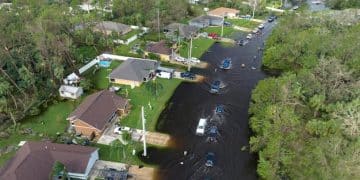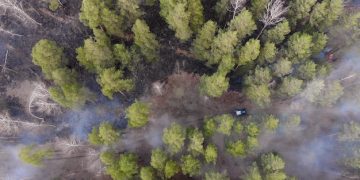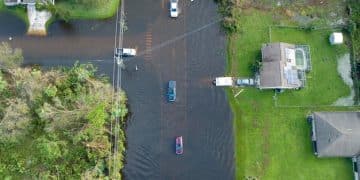Extreme Weather Pet Safety: Protecting Animals in Disasters

Preparing pets for extreme weather events is crucial for their survival and well-being, encompassing proactive measures like creating emergency kits, microchipping, establishing evacuation plans, and understanding species-specific needs to ensure their safety during natural disasters.
As climate patterns shift, the intensity and frequency of extreme weather events pose unprecedented challenges to communities worldwide. Amidst the chaos and concern for human safety, a critical, often overlooked aspect is animal welfare. Ensuring Extreme Weather and Pet Safety: Protecting Your Animals During a Disaster is not just a responsibility but a moral imperative for pet owners.
Understanding the Risks: How Extreme Weather Impacts Pets
Extreme weather phenomena, from hurricanes and blizzards to floods and wildfires, present unique dangers to domestic animals. Their vulnerability is heightened by their dependence on humans for shelter, food, water, and safety. Understanding these specific risks is the first step in developing effective protection strategies.
Pets can experience significant stress and disorientation during severe weather events. Loud noises, sudden environmental changes, and displacement can lead to anxiety, attempts to escape, and even aggressive behavior. This emotional toll can be as damaging as physical threats.
Heatwaves and Droughts
During prolonged heatwaves, pets are susceptible to heatstroke, dehydration, and paw pad burns from hot surfaces. Dogs, especially those with short snouts, heavy coats, or pre-existing health conditions, are particularly vulnerable. Access to fresh water and shade becomes paramount. Droughts, often accompanying heatwaves, can also lead to scarcity of resources and increased wildfire risk, impacting air quality and safe outdoor spaces.
- Provide constant access to fresh, cool water.
- Limit outdoor time during peak heat hours.
- Never leave pets in parked cars, even for short periods.
- Use paw protection on hot pavement.
Floods and Hurricanes
The dangers associated with floods and hurricanes include drowning, hypothermia, exposure to contaminated water, and being swept away by strong currents. Pets can also become trapped in rising waters or enclosed spaces. Post-flood environments often harbor diseases and pose risks from debris and unseen hazards.
Preparing for these events involves understanding evacuation routes and shelters that accommodate pets. Many general shelters do not permit animals, necessitating prior research to identify pet-friendly options or making arrangements with friends and family outside the hazard zone.
Wildfires and Air Quality
Wildfires pose immediate threats of burns, smoke inhalation, and displacement. Pets may panic and flee, becoming lost in unfamiliar or dangerous terrain. Even if not directly in the fire’s path, smoke can travel long distances, causing respiratory issues, especially in animals with pre-existing conditions like asthma.
- Monitor air quality reports and keep pets indoors when hazardous.
- Secure pet carriers and leashes for rapid evacuation.
- Be aware of ash and debris that can irritate paws or be ingested.
Winter Storms and Blizzards
Winter weather brings risks of frostbite, hypothermia, and exposure to toxic substances like antifreeze or de-icing salts. Short-haired breeds, puppies, and senior animals are most susceptible to cold-related injuries. Loss of power during blizzards can also affect indoor temperatures, making homes unsafe.
It’s crucial to provide adequate shelter, warmth, and monitor outdoor time. Simple precautions can make a significant difference in preventing cold-related emergencies.
Building Your Pet Emergency Kit: Essential Supplies for Disasters
Just as you prepare a disaster kit for your family, a dedicated emergency kit for your pets is indispensable. This kit should be readily accessible and contain all necessary items to sustain your animals for at least 5-7 days. Thinking ahead and assembling these supplies can drastically improve your pet’s chances of survival and comfort during a crisis.
The contents of your pet’s emergency kit should go beyond basic food and water. It needs to accommodate their specific physical and emotional needs, recognizing that a disaster can disrupt vital services and veterinary care. Regularly checking expiration dates and rotating stock ensures the kit remains viable.
Food and Water
Store enough non-perishable pet food and fresh water for at least a week. Dry food should be kept in airtight, waterproof containers. Canned food has a longer shelf life and can provide additional moisture. Don’t forget bowls for food and water, preferably collapsible ones for easy packing. A manual can opener may also be necessary if you opt for canned food.
Medications and Veterinary Records
A supply of any prescription medications your pet takes, along with copies of their veterinary records, vaccination history, and identification documents (like microchip information), is crucial. Keep these documents in a waterproof bag. It’s also wise to include a basic pet first-aid kit with items like antiseptic wipes, bandages, and tweezers.

Identification and Comfort Items
Ensure your pet wears current ID tags with your contact information. Include a recent photo of your pet, preferably one of you with your pet, to aid in identification if you get separated. Familiar items like a favorite toy, blanket, or a piece of your clothing can provide comfort and reduce stress in an unfamiliar environment.
- Current photos of your pet.
- Favorite toys or blankets to reduce stress.
- Sanitation supplies: litter and pan for cats, waste bags for dogs.
- Leashes, harnesses, and secure carriers for each pet.
Carrier and Leash
Each pet should have a secure, comfortable carrier large enough for them to stand and turn around. Label carriers with your contact information. Leashes and harnesses are essential for safe transport and control, especially if your pet is anxious or in an unfamiliar setting.
Creating an Evacuation Plan: Where Will Pets Go?
A robust evacuation plan is perhaps the most critical component of pet safety during extreme weather. It must include pre-identified pet-friendly shelters or alternative accommodations, a clear understanding of evacuation routes, and a systematic approach to gathering your pets quickly and safely.
Many public shelters do not allow pets due to health and safety regulations, with the exception of service animals. This means you cannot assume your pet will be welcome at the same place you seek refuge. Planning ahead is non-negotiable to avoid difficult last-minute decisions.
Pet-Friendly Locations
Research hotels or motels outside your immediate area that welcome pets. Many hotel chains now have pet-friendly policies, but it’s essential to confirm this in advance. Create a list of these establishments with their contact information. Explore options with friends or relatives who live outside your potential evacuation zone and are willing to host you and your pets.
Identify animal shelters or boarding facilities in safer regions that could temporarily house your pets. These places often fill up quickly during emergencies, so having a reservation or understanding their procedures in advance is highly recommended.
“Pets Inside” Decals and Rescue Alert Stickers
While preparing to evacuate, place a “Pets Inside” decal or rescue alert sticker on a prominent window or door near your primary entrance. On the back of this sticker, write the number and type of pets in your home. This assists emergency responders in locating and rescuing animals if you cannot return home or evacuate in time.
- Post “Pets Inside” decals clearly visible to first responders.
- List the number and species of animals on the decal.
- Ensure the decal is resistant to weather conditions.
Practice Your Plan
Periodically practice your evacuation plan with your pets. This familiarizes them with carriers and car travel, reducing stress during an actual emergency. Know your primary and secondary evacuation routes. Remember, a calm owner often leads to a calmer pet during stressful events.
Pet Identification and Tracking: Reuniting with Lost Animals
In the chaos of a disaster, pets can easily become separated from their families. Effective identification and tracking methods significantly increase the chances of a successful reunion. This goes beyond simple ID tags and embraces technological solutions and proactive measures.
The sheer volume of lost and displaced animals after major disasters can overwhelm local animal shelters and rescue organizations. Proper identification helps these agencies process animals more efficiently and reconnect them with their owners, reducing the burden on an already strained system.
Microchipping
Microchipping is one of the most reliable forms of permanent identification. A tiny chip, no larger than a grain of rice, is painlessly implanted under your pet’s skin. This chip contains a unique identification number that can be scanned by veterinary clinics and animal shelters. Ensure your contact information associated with the microchip database is always up to date, especially if you move or change phone numbers.
ID Tags and Collars
Even with a microchip, your pet should always wear a collar with current ID tags. These tags should include your name, phone number, and address. Consider adding a tag with “Needs Medication” or “Medical Condition” if applicable. A rabies tag is also important as it links to current vaccination records.

Photographs and Descriptions
Keep recent, clear photographs of your pet from different angles. Include a photo of you with your pet, which serves as proof of ownership. Detailed written descriptions of your pet’s unique markings, breed, size, and any distinguishing features will be invaluable if you need to create “lost pet” flyers or register them with recovery databases.
- Take high-quality photos regularly.
- Note unique markings, scars, or distinct behaviors.
- Compile a detailed description document.
Online Pet Recovery Services
Register your pet with online pet recovery services that use a network of volunteers and professionals to help find lost animals. These services often provide additional tags or collars with unique IDs that link back to your contact information through their database.
Special Considerations for Different Animals and Circumstances
While general preparedness guidelines apply broadly, different types of animals and varying circumstances necessitate tailored approaches to pet safety during disasters. Recognizing these specific needs ensures a more comprehensive and effective protection plan.
A “one-size-fits-all” approach to disaster preparedness for pets can be inadequate. Factors such as species-specific behaviors, mobility challenges, age, and health status all play a role in determining the most appropriate safety measures.
Cats vs. Dogs
Cats often react differently to stress than dogs. They may hide, become elusive, or show aggression. Carriers are essential for feline evacuation. Dogs generally adapt better to leashes and harnesses but may still require special handling depending on their temperament and training. Some breeds are more susceptible to certain environmental conditions than others.
Cats require a litter box and litter in their emergency kit, while dogs need waste bags and familiar walking routines if possible. The emotional support items might differ too; a cat might prefer a quiet, enclosed space in their carrier, whereas a dog might benefit from a favorite chew toy.
Small Animals and Birds
Small animals like hamsters, guinea pigs, and rabbits, along with birds, require their specific cages and bedding for transport. Ensure these carriers are secure and provide adequate ventilation. Their diets are often specialized, so include a generous supply of appropriate food, bedding, and any necessary supplements.
- Provide their usual cage or secure, well-ventilated carrier.
- Pack specific foods and bedding they require.
- Ensure adequate ventilation and protection from drafts/extreme temperatures.
Reptiles and Exotic Pets
Reptiles have unique environmental needs regarding temperature and humidity. Specialized heating elements and water sources might be necessary during evacuation. Exotic pets often require highly specialized care and may not be accepted at general pet-friendly facilities, making pre-arrangements with a vet or specialized animal rescue crucial.
Transporting these animals safely requires careful planning. For example, some reptiles need specific temperature ranges to survive, which can be challenging to maintain during an evacuation. Consult with a veterinarian specializing in exotic animals for tailored advice.
Barn Animals and Livestock
Evacuating horses, cattle, and other livestock presents significant logistical challenges. This requires pre-established routes, trailers, and receiving locations. If evacuation is not possible, a plan for providing adequate food, water, and secure shelter on-site is essential. Consider identifying safe high ground for livestock in flood-prone areas or open pastures away from structures in fire-prone regions.
After the Storm: Returning Home and Recovery
The period after an extreme weather event can be just as critical for pet safety as the event itself. Returning home requires caution and careful assessment of the environment to ensure it’s safe for both humans and animals. Recovery is a phase where pet owners must remain vigilant and proactive.
The landscape of your home and neighborhood may be drastically altered, presenting new hazards. Pets, relying heavily on routine and familiar surroundings, can react unpredictably to these changes. Their emotional and physical well-being remains a top priority during this transitional phase.
Assess the Environment
Before allowing your pets to roam freely, thoroughly inspect your home and yard for hazards such as broken glass, exposed wiring, sharp debris, contaminated water, or displaced wildlife. Downed power lines and gas leaks pose invisible threats. Pets are often curious and may ingest dangerous substances or injure themselves on unseen objects.
- Check for structural damage, gas leaks, and electrical hazards.
- Clear debris and potential toxins from animal access areas.
- Be aware of displaced wildlife that may pose a threat.
Re-establish Routine and Comfort
Disasters disrupt routines, which can be highly stressful for pets. Re-establishing their regular feeding schedules, exercise routines, and quiet spaces as soon as possible helps them regain a sense of normalcy and security. Provide plenty of fresh water and their regular food.
Engage in calming activities like gentle play or quiet cuddle time to reassure your pet. Observe their behavior for any signs of prolonged stress, anxiety, or illness that might require veterinary attention.
Monitor for Health Issues and Stress
Watch your pets closely for any signs of injury, illness, or behavioral changes in the days and weeks following the disaster. Stress can manifest in various ways, including lethargy, changes in appetite, excessive grooming, or aggression. Exposure to contaminated water or food can lead to gastrointestinal issues, while respiratory problems might arise from smoke or mold. Contact your veterinarian if you have any concerns.
Update Records and Replenish Supplies
Once you are safe and resettled, take time to update any contact information for your pet’s microchip or ID tags if necessary. Replenish your emergency kit supplies, ensuring everything is ready for a future event. This proactive approach ensures continuous preparedness for what may come.
Community and Preparedness: Collaborative Pet Safety Initiatives
Individual preparedness is vital, but community-level initiatives significantly enhance overall pet safety during extreme weather events. Collaboration between pet owners, local authorities, animal welfare organizations, and emergency services is crucial for a resilient response.
A unified approach ensures that resources are effectively allocated, information is widely disseminated, and vulnerable pet populations receive the support they need. This collective effort builds a stronger safety net for animals during times of crisis.
Local Emergency Management Agencies
Stay informed about your local emergency management agency’s plans for pets during disasters. Many agencies now include pet considerations in their emergency protocols, offering guidance on pet-friendly shelters, evacuation routes, and animal rescue efforts. Attending community meetings or signing up for local alerts can keep you updated.
Support or advocate for policies that integrate animal welfare into broader disaster preparedness frameworks. This includes funding for temporary animal shelters, training for first responders in animal handling, and clear communication channels for pet owners.
Volunteer and Support Animal Shelters
Local animal shelters and rescue organizations play an indispensable role in disaster response. They often serve as temporary housing for displaced animals, facilitate reunions, and provide essential veterinary care. Volunteering your time or donating supplies and funds can significantly bolster their capacity to help.
- Donate money or supplies to local animal shelters.
- Volunteer time to assist with animal care or re-homing efforts.
- Participate in emergency drills or training programs for animal rescue.
Neighborhood Networks
Establish a network with neighbors, friends, and family to create a mutual aid system for pet care during emergencies. This could involve agreeing to check on each other’s pets if one person is away or assisting with evacuations if a neighbor needs help. Knowing who can lend a hand when disaster strikes provides an extra layer of security.
Community bulletin boards or neighborhood social media groups can be effective platforms for sharing information, coordinating efforts, and identifying local pet-friendly resources. A strong, informed community is better equipped to handle the challenges of extreme weather events together.
| Key Aspect | Brief Description |
|---|---|
| 🐾 Emergency Kit | Assemble 5-7 days of food, water, meds, and comfort items for each pet. |
| 🗺️ Evacuation Plan | Identify pet-friendly shelters or places to stay, and practice routes. |
| 🏷️ Pet Identification | Microchip, current ID tags, and recent photos are vital for reunion. |
| 🛠️ Post-Disaster Care | Safely assess home, re-establish routine, and monitor pet health. |
Frequently Asked Questions
▼
A basic pet emergency kit should include at least a week’s supply of food and water, necessary medications, copies of veterinary records, leashes, collars with ID tags, comfort items like a favorite toy or blanket, and carriers. Don’t forget bowls, waste bags or litter, and a manual can opener if using canned food.
▼
Start by researching hotels or motels outside your immediate area that accept pets. Contact your local emergency management agency, humane society, or animal shelters, as they often have lists of pet-friendly resources or designated animal sheltering facilities during disasters. Discuss options with friends or family who live in safe zones.
▼
Yes, microchipping is highly recommended even if your pet wears ID tags. Collars can slip off or tags can become lost or unreadable. A microchip provides permanent identification that can be scanned by veterinarians and shelters, significantly increasing the chances of reuniting with your pet if they get lost, especially during chaotic disaster scenarios.
▼
Cats are often more prone to hiding when stressed; ensure their carrier is easily accessible. Practice getting them into the carrier beforehand. Include a small litter box, litter, and their preferred food in their emergency kit. During evacuation, keep them in their carrier to prevent escape. Provide a familiar blanket for comfort.
▼
For livestock, develop an evacuation plan that includes routes and destinations early. Have trailers ready and ensure animals are trained to load them. If evacuation isn’t possible, identify safe, high ground for floods or sheltered areas protected from wind and fire. Store extra feed, water, and veterinary supplies on-site. Work with local agricultural services.
Conclusion
Protecting our beloved animals during extreme weather demands proactive planning, diligent preparation, and a deep understanding of their unique needs. From assembling comprehensive emergency kits and formulating precise evacuation strategies to ensuring robust identification methods and fostering community collaboration, every step contributes to their safety and well-being. The responsibility of pet ownership extends beyond daily care to safeguarding their lives and offering comfort during times of crisis, ensuring peace of mind for both pets and their devoted human companions.





